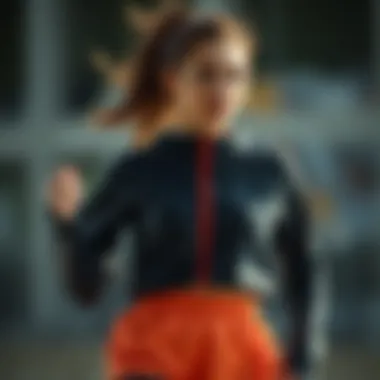The Evolution of Running Active Wear: Functionality Meets Style


Intro
As the world of running active wear continues to evolve, the intertwining of function and fashion is becoming more pronounced than ever. Initially born out of necessity, athletic wear has transitioned from mere practical garments into high-fashion statements. The guiding principles have shifted, with athletes and fashion enthusiasts alike seeking apparel that not only enhances performance but also aligns with personal style. This transformation offers insights into broader social trends and reflects a growing awareness of sustainable practices within the industry.
Today’s consumers refuse to prioritize functionality over aesthetics or vice versa. Thus, it has become imperative for designers and brands to create garments that encapsulate both elements. Engaging with this duality not just elevates the experience for users but also speaks volumes about the shifting landscapes both in the fashion industry and athletics. The concept of mindful consumerism adds another layer, encouraging individuals to make intentional choices that support sustainable practices.
This article aims to dissect the evolution of running active wear through various lenses, offering a unique perspective on its key components and emerging trends. From examining fashion trends to providing practical styling tips, this narrative will empower designers, stylists, and fashion aficionados with the knowledge to navigate the current climate of active wear. Prepare to explore a world where comfort collides with couture and sustainability takes center stage.
Preamble to Running Active Wear
Running active wear has taken center stage in the athletic apparel world, reflecting not only the shifts in fashion but also advancements in technology and understanding of performance needs. As running becomes an increasingly popular activity at both competitive and recreational levels, the importance of suitable gear cannot be overstated. Choosing the right active wear transcends simple aesthetics; it plays a critical role in enhancing the runner's experience, providing comfort, support, and even injury prevention.
Understanding Active Wear
Active wear is not just clothing; it is a fusion of form and function designed to meet the rigorous demands of movement and sweat. It encompasses a wide range of garments including leggings, shorts, tops, and outerwear. Primarily, these pieces are built with specific activities in mind. For instance, running specific materials, such as synthetic blends or elastic fabrics, help in maximizing flexibility and comfort. When choosing running apparel, understanding these nuances is key. The garments must fit well and allow for a full range of motion, which directly influences performance outcomes.
Furthermore, the concept of active wear has evolved to cater to a variety of consumer needs, addressing factors like climate, style preferences, and practicality. Therefore, a well-rounded piece of active wear does more than just its job; it resonates with the wearer's lifestyle and personal aesthetic, ensuring that users don't just feel good while running, but also look good. Being aware of these characteristics leads to informed choices that can enhance both the running experience and the wearer’s enthusiasm toward maintaining an active lifestyle.
The Importance of Choosing the Right Gear
Selecting the appropriate gear is paramount for any runner, novice or seasoned. There are substantial benefits tied to this consideration that go beyond mere temperature regulation and moisture management. Comfortable and well-fitting garments can help prevent chafing and other discomforts that could dampen performance and motivation. Imagine a long run interrupted by fabric rubbing against skin – that's a mood killer for sure.
The psychological aspect of wearing suitable active wear also cannot be dismissed. When you feel good in what you’re wearing, it can boost confidence. Moreover, the materials used not only affect comfort but also impact functionality. For example, garments embracing moisture-wicking properties keep sweat away from the body, allowing for a drier and more enjoyable run.
In summary, the right choice in active wear takes into account quality, fit, and the specific demands of running. These considerations are integral for maximizing both performance and enjoyment, making it easier to lace up those shoes and head out the door.
"The right gear not only supports performance but establishes a mindset conducive to achieving athletic goals."
Choosing to research and invest in quality running active wear offers a pathway to enhance well-being, function, and style. This level of insight serves as a jumping-off point for the ongoing exploration of historical context and material innovations, further enriching the understanding of running active wear.
Historical Context
The historical context of running active wear is not just a backdrop; it's the very foundation that shapes its modern incarnation. Understanding its journey through time unveils the synergy between function and style. In this article, we explore how past influences have steered the design, materials, and philosophies behind contemporary running wear, laying bare the essential lessons we can glean from its evolution. This context is crucial for fashion designers, stylists, and retailers as it offers insight into consumer preferences and the shifting dynamics of athletic fashion.
The Origin of Athletic Clothing
Athletic clothing, as we perceive it today, has roots that can be traced back to the ancient civilizations, where the focus was more on comfort and utility than aesthetics. The Greeks famously competed in the nude during the ancient Olympics, a testament to their prioritization of freedom of movement. However, as time ticked on, the significant shift in athletic apparel began in the 19th century.
From the cotton clothing worn by early athletes to the introduction of more functional garments like woolen shorts, the accentuating need for performance became evident. In the late 1800s, the emergence of a more organized sporting culture called for more specialized clothing. The birth of running shoes, particularly with the likes of the Converse All Stars and Adidas in the early 20th century, marks a pivotal juncture. During this period, elements such as the fit and function of clothes took precedence, providing runners with the much-needed support and flexibility.
Evolution Through the Decades
Fast forward through the decades, and the progression of active wear echoes societal changes and technological advancements. The 1960s witnessed a burgeoning interest in fitness culture. Tracksuits, made popular by athletes like Jim Hines, epitomized the blend of athletic prowess and fashion sensibility. The introduction of synthetic materials such as nylon and polyester revolutionized the scene, allowing for lighter, moisture-wicking options that became household staples.
Moving into the 1980s and 1990s, the rise of aerobics and jogging clubs further cemented active wear as a lifestyle choice. Iconic brands like Nike and Reebok began catering not just to athletes, but to the everyday person looking for comfort in their daily attire. The psychedelic colors and vibrant patterns marked a shift where fashion began to intertwine more explicitly with function, paving pathways for individual expression through athletic wear.
In contemporary times, active wear is characterized by a profound convergence of style and functionality. Designers now have access to technologically advanced materials that enhance performance—think of fabrics that regulate temperature or repel liquids. Consumer awareness regarding sustainability also shapes choices today, making ethical considerations a critical focal point for brands.
The evolution of running active wear reflects not only technological advancements but also shifting societal attitudes toward health, fitness, and self-expression.
Thus, the historical journey of running active wear illustrates how functionality has always been layered with the essence of style. Recognizing these trends can provide insightful perspectives for stakeholders throughout the industry.
Key Materials in Running Active Wear
The selection of materials in active wear plays a pivotal role in ensuring both functionality and performance. As runners consistently seek comfort and efficiency, the materials in their gear must adapt to these changing expectations. This section will explore the critical elements that make up quality running active wear, focusing on breathability, moisture-wicking features, and insulation techniques. Understanding these components not only aids in optimizing performance but also enhances overall athletic experiences.
The Role of Breathability


Breathability in running gear refers to the ability of a fabric to allow air circulation while simultaneously hushing the moisture-efficient properties. For runners, staying cool and dry is essential. When your body heats up during a jog or sprint, the sweat produced must evaporate effectively; otherwise, it can lead to discomfort and decreased performance.
Modern fabrics designed for breathability often incorporate features such as mesh panels or loosely woven materials. These not only facilitate airflow but can also be surprisingly stylish, adding an extra layer of visual appeal. Choosing tops and bottoms that showcase breathability can alleviate the feeling of being drenched in sweat. This leads to better focus on the run rather than becoming distracted by itchiness or clinginess that can result from heavy, moisture-retaining materials.
Moreover, the term "breathability" can encompass different levels depending on the intended activity. For instance, while a quick 5K may necessitate lightweight breathable gear, longer runs might require a blend of lightweight and mid-weight fabrics that balance insulation during varied weather conditions.
Moisture-Wicking Fabrics
Moisture-wicking fabrics are designed to draw sweat away from the skin to the exterior surface of the garment, where it can evaporate more easily. This process is crucial during vigorous activities since it helps maintain a comfortable body temperature. If the fabric keeps absorbing moisture instead of whisking it away, the runner may inadvertently hinder their performance.
Some popular materials that boast moisture-wicking properties include polyester, nylon, and specific blends containing spandex. They often contain inherent hydrophilic or hydrophobic properties that actively push moisture out. This not only improves comfort during runs but reduces the risk of chafing, which can be a painful nuisance. Many runners can attest that the right moisture-wicking gear can be the difference between an enjoyable run and a sweat-drenched ordeal, especially during those grueling summer months.
"Understanding moisture-wicking technology empowers athletes to choose active wear that better aligns with their performance needs."
Insulation Techniques
Insulation in running active wear becomes particularly significant when going the distance in colder climates. While breathability and moisture control are crucial for summer runs, insulation ensures that warmth is maintained when temperatures dip. Insulating materials such as fleece or advanced thermal fabrics provide an added layer to prevent heat loss.
For instance, brands often develop specialized thermal fabrics that are lightweight yet trap warmth efficiently, allowing for easy movement without bulk.
An effective way to manage insulation layers is by adopting a layering strategy – a base layer to wick away moisture, a mid-layer for warmth, and an outer layer for protection against the elements. This approach gives athletes the flexibility to adjust according to changing temperatures or conditions throughout their run.
Ultimately, the evolution of materials used in running active wear is crucial for elevating the overall experience of the runner, merging functionality with emerging fashion trends.
Design Elements of Contemporary Active Wear
When it comes to running active wear, design elements are pillars that support both functionality and style. In today’s fast-paced world, athletes and fitness enthusiasts seek gear that not only enhances performance but also reflects personal fashion. Understanding how these elements come together can elevate running experiences to greater heights.
Fit and Comfort Features
A well-fitted piece of active wear can feel like a second skin. It’s not just about looking good; it’s about moving freely without distractions. The snugness of a garment plays a crucial role in determining how well it performs under stress. Features such as flat seams help avoid chafing, while ergonomic patterns accommodate natural movement during runs.
Consider the rise of compression clothing. Designed to support muscles, these items provide a tighter fit that eases fatigue during vigorous activity. Additionally, the trend of incorporating adjustable components, like drawstrings or expandable waistband designs, ensures that the garment can cater to various body shapes and sizes. The psychological impact is noteworthy as well; wearing something that feels comfortable can boost confidence and, as a result, performance.
Aesthetic Trends
Just as important as comfort is the visual appeal of running wear, which has evolved dramatically. Gone are the days when athletic clothing was merely functional. Designers today blend artistry with innovation, creating pieces that catch the eye whether in a race or at a cafe. The influx of bold colors, unique prints, and captivating graphics allows wearers to express individuality while staying fit.
Textures also play a significant role in current fashion. With brands mixing materials, we see a variety of surface looks—from matte to glossy—that add depth to standard apparel. That blend opens up a world of creativity for designers. Additionally, the rise of gender-neutral designs caters to diverse markets, promoting inclusivity.
"Fashion and function are not mutually exclusive; they can coexist beautifully in today's active wear landscape."
Functionality Versus Style
Navigating between functionality and style is a delicate dance for many brands. Consumers crave active wear that performs well—it's vital that clothing can manage moisture, provide breathability, and withstand rigorous movements, especially when on the run. Yet, the challenge remains: how do we maintain these practical benefits while ensuring aesthetic appeal?
Companies increasingly employ synthetic blends that not only serve practical purposes but also showcase contemporary designs. Smart textile technology is a blossoming field here. Fabrics featuring built-in UV protection or temperature-regulating properties are becoming the norm.
Balancing the two often leads to creative innovations. Consider the rise of multifunctional items—garments like joggers that have smart pockets or tank tops that can transform into stylish off-duty wear.
In recent years, the need for simplification of wardrobe choices has drawn attention. An increasing number of consumers are investing in pieces that can transition seamlessly from road runs to everyday wear, embodying a blend of both worlds.
Through careful consideration of fit, aesthetic, and functionality, contemporary active wear designs not only serve the needs of athletes but also allow individuals to express their personal style in every stride.
Sustainability in Running Active Wear
In the ever-evolving world of fashion, sustainability has emerged as a crucial topic, particularly in the realm of running active wear. As consumers become more conscious of their impact on the environment, brands have taken notice, seeking to merge performance with eco-friendly practices. This not only appeals to the ethical consumer but also drives forward-thinking brands to innovate in material selection, production methods, and overall design. The significance of incorporating sustainability into active wear lies in the surge of benefits it brings, including reduced environmental footprints, improved social conditions, and the promotion of long-lasting use rather than disposable culture.


Ethical Manufacturing Practices
One of the linchpins of sustainability in active wear is ethical manufacturing practices. This involves ensuring that the production processes are not just environmentally friendly but also socially responsible. Many brands now prioritize working with factories that guarantee fair wages and safe working conditions. Adopting certifications such as the Fair Trade or Global Organic Textile Standard (GOTS) can serve as an evidence of commitment to these practices. Participants in this space are often transparent about their supply chains, allowing consumers to make informed decisions. The dedication to these principles results in apparel that not only performs well but also resonates with values aligned with the greater good.
Moreover, ethically sourced materials are on the rise. Instead of relying on low-cost fabrics from dubious origins, brands are turning to local and sustainable resources. Think of companies like Patagonia, which actively advocates for environmental responsibility, encouraging their customers not just to buy but also repair and recycle their gear.
"A sustainable performance piece does not just stand out in design but thrives in its ethical journey from raw material to retail."
Material Innovations for Sustainability
Equally important in achieving sustainability in active wear is the exploration of material innovations. Technological advancements have paved the way for fabrics that boast eco-friendly characteristics. For instance, recycled polyester made from plastic bottles offers a sustainable alternative without compromising performance. This innovative material provides the same moisture-wicking capabilities required for high-intensity running while diverting waste from landfills.
Another notable advancement is the use of natural fibers, such as bamboo and organic cotton, which are biodegradable and require less water in their production compared to conventional crops. These materials not only support the planet but also appeal to consumers looking for comfort and breathability.
Here are some key materials that are shaping the future of sustainable running active wear:
- Recycled Polyester: Derived from post-consumer plastic waste.
- Organic Cotton: Grown without harmful pesticides or fertilizers.
- Tencel: Made from sustainably sourced wood pulp, known for its softness.
- Econyl: Regenerated nylon sourced from fishing nets and other nylon waste.
Incorporating these materials not only meets the growing demand for stylish active wear but also ensures that the environmental burden is substantially lessened. Good active wear should feel nice against your skin while doing its part for the planet.
As running active wear continues down the path of sustainability, both brands and consumers hold responsibility. The message is clear: while we pursue performance and style, we should never lose sight of our role in nurturing the Earth.
Styling Running Active Wear
In the world of athletic clothing, where performance is often prioritized, the importance of styling running active wear cannot be overlooked. With the rise of athleisure trends, athletes and fitness enthusiasts alike no longer confine their outfit choices to purely functional designs; they seek pieces that perform well while also looking good. Styling running active wear blends the realms of functionality and aesthetics, providing a comprehensive approach to how active wear can transition seamlessly between workouts and social settings.
Considerations for Styling
When selecting running gear, several stylistic elements come into play. Fit, color, and layering all contribute not just to comfort during a run, but also to the perception of the wearer outside of the gym. This duality is essential; whether at a coffee shop post-run or on a leisurely stroll, active wear needs to be versatile.
One consideration is how layering can adjust to changing temperatures, as one may start their run in cool weather but find it warms up quickly. This capability enhances not only comfort but also style. Also, opting for items that can be mixed and matched allows for a wide range of outfit possibilities without overcrowding one’s closet.
"Active wear that can serve both form and function empowers the wearer, improving confidence and performance."
Now let’s break this down further into Layering Techniques and Transitioning from Gym to Street.
Layering Techniques
Layering is an art, particularly when it comes to running active wear. The goal is to keep comfortable while adapting to different weather and activity levels. The base layer acts as the foundation; it’s essential for moisture management, typically made from materials such as polyester or nylon that wick sweat away from the skin. A snug fit is crucial here, as this layer needs to stick just enough to perform effectively without becoming restrictive.
On top of the base layer, mid-layers can be added for insulation. Fleece or lightweight jackets can serve this purpose well, offering warmth without bulk. Finally, an outer layer is protective against wind and rain, often made from breathable and waterproof fabrics.
When layering, balance and proportion are important. Avoid chunky pieces that can weigh you down. Opt for lighter materials that keep the silhouette sleek. Dark colors can be flattering and practical, hiding any sweat marks, while bright colors offer visibility and style. Playing with textures can also produce a unique look.
Transitioning from Gym to Street
The lines between gym attire and street style are becoming increasingly blurred. Choosing active wear that transitions well from exercise to casual outings requires careful selection.
Pairing high-waisted leggings with a crop top creates a stylish yet functional outfit. A loose-fitting tank can also serve as a quintessential piece, allowing one to remain cool during workouts while also looking trendy outside the gym. Footwear plays a significant role here; opting for stylish sneakers instead of running shoes can elevate an otherwise gym-centered look.
Accessories help to elevate the active wear experience as well. A sleek backpack or a smart watch adds elements of style to what could otherwise feel too athletic. Think about incorporating street-savvy items, such as caps or oversized jackets, to further marry function with a fashionable flair.
Choosing the Right Active Wear for Different Activities
When it comes to choosing active wear, the old adage "one size fits all" doesn't cut it. Different activities have different demands, and the right gear can make a world of difference in both performance and comfort. Picking out the proper attire for running or other cardio exercises compared to strength training or yoga hinges on a pivotal understanding of the unique requirements that each the task involves.
Running Versus Other Training Types
Running, while widely celebrated for its health benefits, presents its own set of conditions that gear needs to meet. For instance, runners often benefit from lightweight fabrics that allow for maximum breathability and moisture-wicking capabilities. These features help in coping with perspiration, a constant companion on those long runs. The technical performance fabrics like polyester blends or nylon mesh come into play, providing compression where it’s needed, and aiding muscle recovery.


On the other hand, strength training demands a different approach. While ongoing flexibility remains essential, thicker and more durable fabrics might be preferred. The reasoning is simple: lifting weights requires movement and stability, meaning you might need apparel that resists wear-and-tear but still allows freedom of motion. Think of materials like spandex or cotton-elastane blends for t-shirts and leggings.
It's also noteworthy that footwear varies considerably across these disciplines. For strong performance in running, shoes rely heavily on cushioning and support that absorbs impact. In contrast, a training shoe favors stability and grip to ensure safety during work with heavier weights.
Seasonal Considerations
Just like different activity types dictate the fabric, seasonality plays a significant role in selecting appropriate active wear. When the sun is blazing, lightweight synthetic materials with UV protection features are often the star of the show. Breathable tanks and shorts are excellent for those sweaty summer runs.
When winter rolls around, however, layering becomes key. The base layer should focus on moisture-wicking to keep sweat away, while insulating materials for the outer layer, like fleece or down, can help fend off the chill. This makes it vital to select active wear that contours with the body yet traps warmth efficiently.
To sum it up, recognizing the right pair of shoes or the right fabric alone isn't a magic formula. Meeting practical demands set by specific activities and considering seasonal variations creates an effective synergy that defines comfort in active wear.
“When you know how to pick your active wear, it’s like having a cheat sheet to your performance.”
Choosing active wear tailored for activities and seasons not only enhances performance but also contributes to an engaged and enjoyable workout experience.
To explore more on specific materials used in active wear, visit: Britannica on Sportswear and understand industry trends on platforms like Reddit for the latest preferences among fitness enthusiasts: Reddit.
Ultimately, the right active wear can turn an ordinary workout into an extraordinary endeavor.
The Future of Running Active Wear
The future of running active wear stands as a crucial component in the ongoing dialogue about sports apparel—blending performance, style, and sustainability into a cohesive whole. As the running community continues to grow, the demand for innovative and adaptable clothing skyrockets. Several key elements shape this future, including technological advancements and emerging consumer trends, which will be explored in detail. These factors not only enhance the athletes' experience but also align with broader societal shifts toward eco-consciousness in fashion, driving brands to rethink their approaches.
Technological Advancements
In the next phase of running active wear, technology plays a pivotal role. Advanced textiles engineered for specific functions are becoming the norm. Fabric innovations such as temperature-regulating materials come to the forefront; they provide wearers with thermal comfort regardless of weather conditions. This means that on a chilly morning jog, a runner can stay warm without overheating.
Additionally, the rise of smart textiles cannot be overlooked. Wearable technology that integrates with clothing—tracking metrics like heart rate, calorie burn, and muscle activity—is getting smarter. Imagine a shirt that not only supports your physique but gives real-time feedback on your performance. This leap in tech-integrated apparel not only broadens functionality but also elevates the running experience into uncharted territory.
Wearable technology isn’t limited to tracking devices either. For example, augmented reality capabilities could provide runners with navigation guidance or environmental data, paving the way for a more interactive running experience. Indeed, the line blurring between clothing and technology hints at an exhilarating future for runners, merging their passions with cutting-edge tools.
Consumer Trends and Demands
The changing preferences and demands of consumers are equally essential to shaping the trajectory of running active wear. In today’s marketplace, there exists a palpable demand for products that resonate with personal identity and values. Modern consumers increasingly favor brands that reflect their beliefs and lifestyles, particularly towards sustainability and ethical practices.
This dynamic often plays out in the form of "buying less, but better," emphasizing quality over quantity. As a result, manufacturers are led to innovate not just in terms of performance but also in the materials they use—biodegradable fabrics and recycled sources are becoming more popular. Meanwhile, transparency in sourcing allows consumers to feel more connected to their purchases, knowing the history and impact their choices carry.
Moreover, the influence of social media cannot be overstated. As platforms like Instagram and TikTok flourish, there's a growing trend of users showcasing their active lifestyle through visually appealing attire. This phenomenon sets a standard where style is just as important as functionality. Individuals want pieces that not only perform well during workouts but also stand out in a casual setting.
"In fashion-forward society, the intersection of style and function is no longer a luxury but a necessity."
Fashion designers, stylists, and retailers need to stay ahead of these trends to cater to an increasingly discerning clientele. The demand for new aesthetics, alongside performance optimization, incites a race among brands to capture the hearts and wallets of consumers.
Epilogue
The significance of this conclusion in the realm of running active wear cannot be understated. It serves as a synthesis of the various elements discussed throughout the article, emphasizing how functionality and style intersect when it comes to athletic clothing. First and foremost, the understanding of key materials such as moisture-wicking fabrics, breathability, and insulation techniques highlights how essential it is for garments to enhance performance. But, it’s not just about performance; the aesthetics of running gear have evolved to attract a fashion-conscious audience.
As sustainability becomes increasingly imperative in modern fashion, recognizing the ethical manufacturing practices and innovative materials provides consumers with more responsible options. The shift towards sustainable active wear is not just a fleeting trend but a vital consideration for designers and brands aiming to meet consumer expectations that evolve in tandem with environmental awareness.
Additionally, the journey from schoolyard sports to marathon runs showcases how far the design elements of active wear have come. This evolution is an inspiring story of how practicality meets fashion, meeting the needs of both serious athletes and casual wearers alike. As such, consumers should consider the balance of style, performance, and sustainability when selecting active wear.
In essence, choosing the right active wear elevates not only personal performance but also contributes to a larger conversation about the future of fashion in sports.
Recap of Key Points
- Materials Matter: The significance of breathable, moisture-wicking fabrics and insulation is paramount.
- Design Evolution: Understanding how fit and aesthetic trends have changed provides insight into consumer preferences.
- Sustainability Stakes: The mechanisms behind ethical manufacturing and sustainable material innovations are crucial amidst rising environmental concerns.
- Functionality Versus Style: It’s essential to find a middle ground that supports performance while appealing to personal style.
- Consumer Trends: Analyzing future demands in active wear illustrates the need for adaptable and ethical options.
Final Thoughts on Active Wear Trends
In closing, the dynamic world of running active wear reflects broader societal shifts towards both performance optimization and sustainable fashion. As consumers become more discerning, the pressure on brands to innovate responsibly will only increase. The growth of running as both a recreational activity and competitive sport means that the intersection of functionality and fashion will continue to flourish. Individuals should not overlook the importance of choosing clothing that not only feels comfortable but also aligns with personal values regarding sustainability and ethical production practices. The future of running active wear stands at a pivotal juncture where every choice we make today will shape what comes next.
In essence, the harmony of purpose and aesthetic in athletic apparel is more than a fleeting trend; it’s a reflection of our evolving relationship with active living and responsible fashion.
For more insights into the sustainable fashion movement, visit Wikipedia or Britannica for comprehensive understandings.















